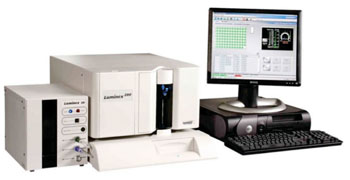Blood Test Identifies Septic Shock Risk Biomarkers
By LabMedica International staff writers
Posted on 10 Apr 2014
A multibiomarker-based approach has been developed to estimate mortality risk in adults with septic shock and tested on blood samples from critically ill patients.Posted on 10 Apr 2014
Septic shock is a severe systemic infection and major cause of death for the old and young alike, but testing new drug regimens to stop the infection is confounded because clinical trials include patients who are either too sick to be saved by experimental therapies or not sick enough to warrant the treatments.

Image: The Luminex 100/200 multiplex analyzer system (Photo courtesy of Luminex).
An international team led by scientists at the Cincinnati Children's Hospital Medical Center (OH, USA) studied 882 adults in intensive care units in medical centers located in the USA, Finland and Canada. The study included three different groups of patients to develop, test and retest the tool. This helps to make sure it works in different patient mixes, often a limiting factor in large clinical trials. The team selected 12 candidate biomarkers from 117 gene probes previously shown to have predictive strength for poor outcomes in microarray-based studies involving children with septic shock.
The plasma concentrations of the candidate biomarkers were measured using a multiplex magnetic bead platform, the MILLIPLEX MAP (EMD Millipore Corporation; Billerica, MA, USA) and a Luminex 100/200 multiplex analyzer system (Luminex Corporation; Austin, TX, USA). Maximum accuracy was achieved with five of the 12 candidate stratification biomarkers: C-C chemokine ligand 3 (CCL3), heat shock protein 70 kDa 1B (HSPA1), interleukin-8 (IL8), granzyme B (GZMB), and C-C chemokine ligand 4 (CCL4). Serum lactate concentration at study entry, age, and presence of chronic disease further improved predictive accuracy.
The data was then used in a mathematical model to combine the information into a single tool that separates high- and low-risk patients. The investigators found that the tool accurately determined that patients who tested positive had less than a 50% chance of surviving, but patients who tested negative had more than a 90% chance of surviving. More detailed analyses allowed the authors to identify patients with a more than a 98% chance of surviving, and those with more than 75% chance of dying.
Hector R. Wong, MD, a lead investigator and director of Critical Care Medicine said, “Substantial resources are invested in trying to find new treatments for septic shock, but the vast majority of them fail when they get to clinical trials. There are many reasons for this, but a consistent one is that the baseline mortality risk varies widely in septic shock patients, which muddies the water.” The study was published in the April 2014 issue of the journal Critical Care Medicine.
Related Links:
Cincinnati Children's Hospital Medical Center
EMD Millipore Corporation
Luminex Corporation












.jpg)
